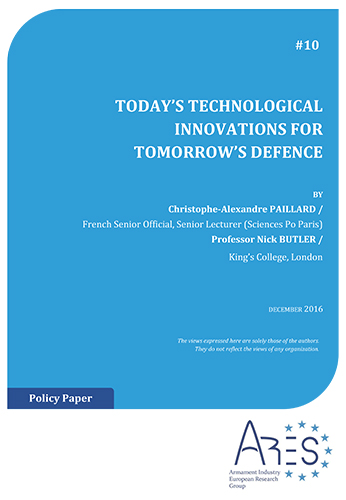Notes / ARES Group - The Armament Industry European Research Group
5 December 2016
Today’s Technological Innovations for Tomorrow’s Defence

Globalisation has been the engine of international business and innovation since the end of the Cold War. New and more advanced forms of global outsourcing are thus very likely to emerge in the next twenty years and it is very likely that the next more advanced stage of globalisation will definitely involve all developed economies and emerging market economies in an ever more global competitive world. For European countries, the difficult strategic and economic times they face mean that they will have to become accustomed the idea of constrained defence budgets for a foreseeable future. For all European countries, budget constraints are compounded by the range of commitments defence budgets must cover. All of their commitments impose costs to which must be added the additional, exceptional costs of military interventions. All this means that defence budgets are stretched to the point of breaking. However, in many European countries, military leaders have talked openly about the lack of capacity to take on major new conflicts or challenges. In these circumstances, the funds available for R&D to shape future conflicts and future patterns of deterrence are very limited.
In reaction to the consequences on defence technologies and budgets of this quickly changing world and taking into account the need to keep a clear technological advance on possible key security challengers for the next thirty years, the United States launched in November 2014 their “Third Offset Strategy” (TOS) to bolster their conventional deterrence. The first offset strategy was developed in the 1950s when President Eisenhower emphasized nuclear deterrence to avoid the larger expenditures necessary to conventionally deter the Warsaw Pact. The second “Offset Strategy” referred to technological superiority to offset quantitative inferiority in conventional forces when compared to the ones of the Soviet Union. However, unlike the first two offset strategies, the third one could rely on commercially driven technology such as robotics, autonomously operating vehicles, guidance and control systems, visualization, biotechnology, miniaturization, advanced computing, big data analytics and additive manufacturing, which also means a real challenge to European industries to take up the gauntlet…

